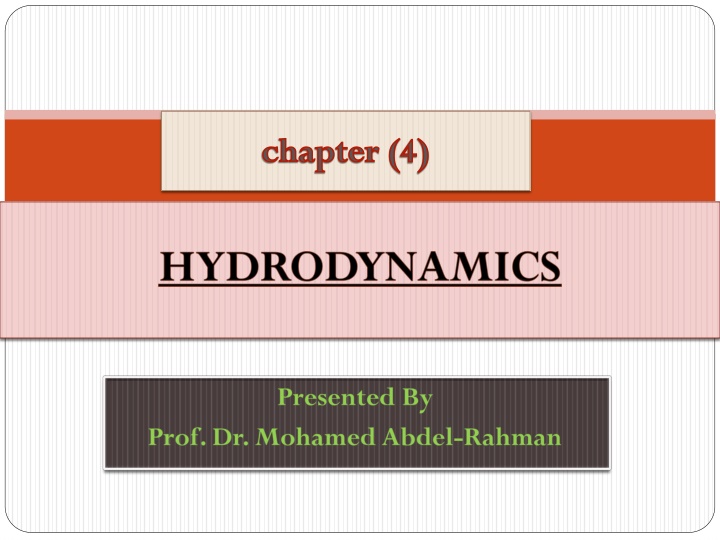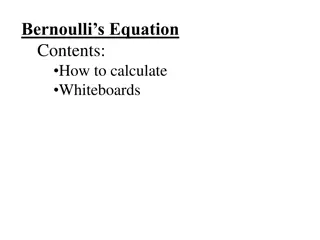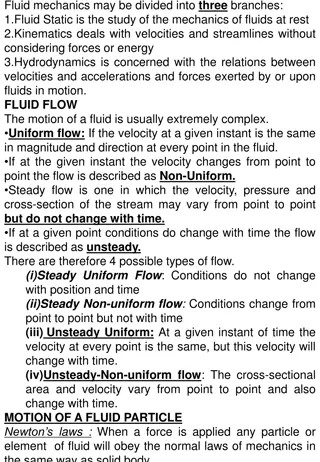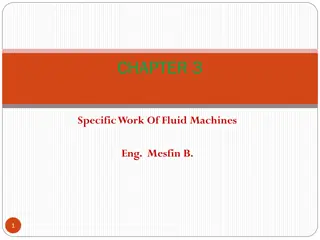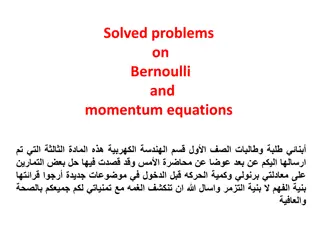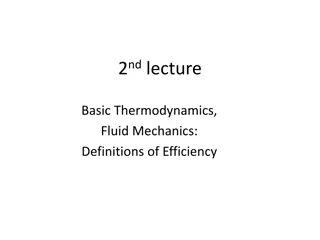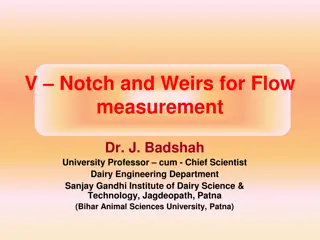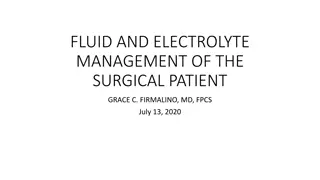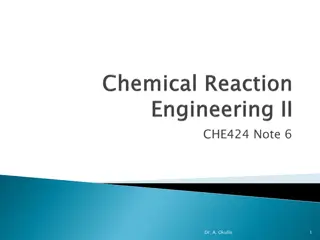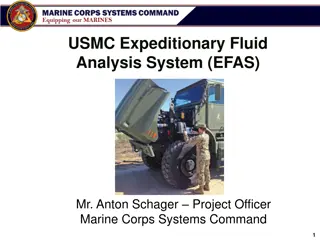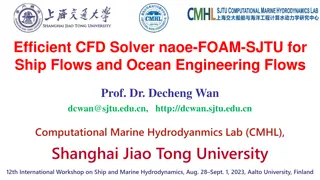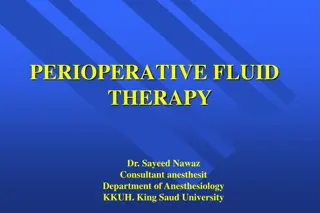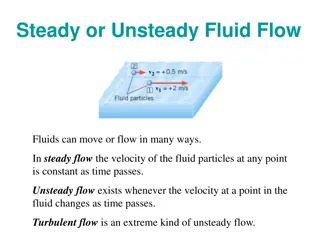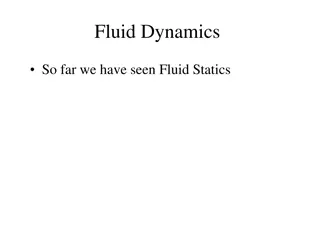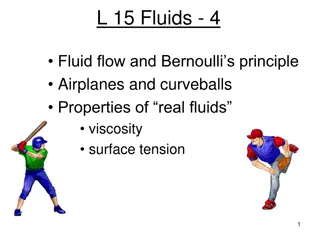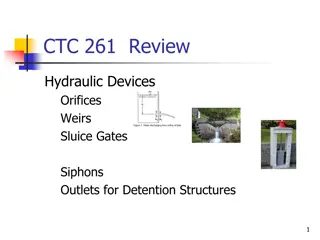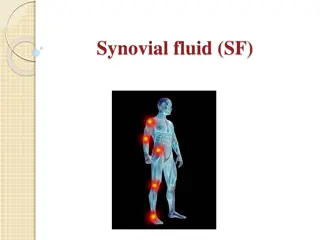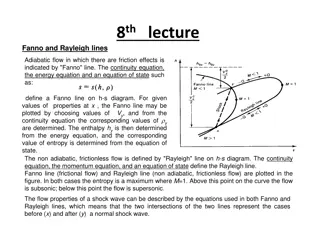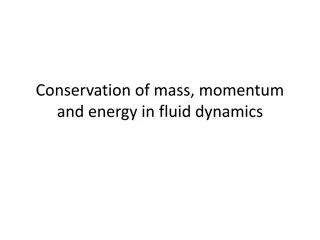Hydrodynamics: Bernoulli's Equation and Fluid Flow Analysis
Understanding Bernoulli's equation in hydrodynamics is key to analyzing fluid flow dynamics. As a fluid moves through varying pipe conditions, pressure, speed, and elevation interact to maintain a constant total energy. This principle, expressed in Bernoulli's equation, showcases the relationship between pressure, kinetic, and potential energy along a streamline. Through a detailed examination of liquid motion in tubes, the equation's application to incompressible fluid flow and energy conservation becomes clearer. Explore the implications of Bernoulli's equation on fluid mechanics and its significance in engineering and physics.
Download Presentation

Please find below an Image/Link to download the presentation.
The content on the website is provided AS IS for your information and personal use only. It may not be sold, licensed, or shared on other websites without obtaining consent from the author.If you encounter any issues during the download, it is possible that the publisher has removed the file from their server.
You are allowed to download the files provided on this website for personal or commercial use, subject to the condition that they are used lawfully. All files are the property of their respective owners.
The content on the website is provided AS IS for your information and personal use only. It may not be sold, licensed, or shared on other websites without obtaining consent from the author.
E N D
Presentation Transcript
HYDRODYNAMICS (cont.) 4.4. Bernoulli s Equation: As a fluid moves through a pipe of varying cross section and elevation, the pressure changes along the pipe. In 1738, Daniel Bernoulli (1700 1782) derived an expression that relates the pressure of a fluid to its speed and elevation. Bernoulli s equation is not a freestanding law of physics; rather, it s a consequence of energy conservation as applied to an ideal fluid. By the work-energy theorem, the work done by the opposing pressures P1and P2equals the difference in mechanical energy between that of the fluid now between points (c) and (D) and the fluid that was formerly between (A) and (B).
HYDRODYNAMICS (cont.) In addition, the liquid moves through a tube of varying elevation and cross section. Then the pressure varies along the tube. Bernoulli s relationship can be derived most conveniently by considering a steady flow of an incompressible liquid through a frictionless pipe of varying cross section and elevation. The motion of the liquid will be taken as sufficiently slow to permit streamline flow (laminar flow). As it moves from a cross- sectional area A1to A2along the streamline, its velocity increases from v1to v2, the elevation as h1and h2and the pressure of the liquid as P1and P2. In a small time interval t the liquid through A1moves a distance x1=v1 t and the work done through this distance is w1=(P1A1)v1 t, where F1=P1A1 and w = F1 x1. According to Equation (2), the work w1per unit time becomes w1=P1 V. Similarly, w2= P2 V through A2in the same time interval t. The net work done on the liquid between the two sections A1 and A2is given by: W = W1-W2= (P1-P2) V ------------- (9)
HYDRODYNAMICS (cont.) This work done by the pressure difference produces the change in kinetic energy and potential energy of the liquid between the two sections A1and A2. if m is the mass of the small volume V of the liquid, its kinetic energy at A1is mv12and at A2is mv22, so that the net change in kinetic energy per unit time between the two sections is: K = m ( v22- v12 ) or: K = V ( v22 - v12 ) -------------- Also, the net change in potential energy of the liquid between the two sections is: U = mg (h2 - h1), U = g V (h2 - h1) -------------- but W = K + U -------------- Substituting Equations (9), (10) and (11) in (12), we get: (P1- P2) V = V (v22 - v12) + g V ( h2 - h1) v12 + gh1 + P1= v22 + gh2 + P2 Therefore, v2 + gh1 + P = constant ----------- Equation (13) is known as Bernoulli s equation. It means that the pressure, kinetic energy per unit volume and potential energy per unit volume has the same value at any point along the streamline. (10) (11) (12) (13)
HYDRODYNAMICS (cont.) Dividing Equation (13) by we get: (v2/2g) +(h) +(p/ g) = constant ---------- (14) (v2/2g) (h) elevation head (p/ g) pressure head velocity head The sum of these three heads is called total head. Also, P is called the static pressure and v2 is called the dynamic pressure. If the tube is horizontal, then h1= h2and ( h1-h2 ) = 0. Therefore, the net work done is: v12 + P1= v22 + P2 or v2 + P = constant -------------- for a flow in an open channel, where P1=P2, then: h1+ (v12/2g) = h2+ (v22/2g) or h + (v2/2g) = constant ---------------- (15) (16)
HYDRODYNAMICS (cont.) 4.5. Applications of Bernoulli s equation: 4.5.1 The Venturimeter An important consequence of Bernoulli s equation as in figure water flowing through a horizontal constricted pipe from region of large cross-sectional area into region of smaller cross- sectional area. This device, called a Venture tube, used to measure the speed of fluid flow. Since the pipe is horizontal, y1= y2, Bernoulli s equation applied to points 1 and 2 gives: Because the water is not backing up in the pipe, its speed v2in the constricted region must be greater than its speed v1in the region of greater diameter. From the above equation, we see that P2must be less than P1because v2> v1. This result is often expressed by the statement that:- swiftly moving fluids exert less pressure than do slowly moving fluids .
HYDRODYNAMICS (cont.) Example 1: A large pipe with a cross-sectional area of 1.0 m2descends 5.0 m and narrows to 0.50 m2, where it terminates in a valve at point (1) (Figure 7). If the pressure at point (2) is atmospheric pressure, and the valve is opened wide and water allowed to flow freely, Find the speed of the water leaving the pipe? Figure 7 SOLUTION: Write Bernoulli s equation: Solve the equation of continuity for v2 : In Equation (1), set P1= P2= P0, and substitute the expression for v2. Then solve for v1:
HYDRODYNAMICS (cont.) 4.5.4. Lift on an aircraft wing The lift on an aircraft wing can also be explained by the Bernoulli effect. Airplane wings are designed so that the air speed above the wing is greater than the speed below. As a result, the air pressure above the wing is less than the pressure below, and there is a net upward force on the wing, called the lift. Another factor influencing the lift on a wing, shown in Figure, is the slight upward tilt of the wing. This causes air molecules striking the bottom to be deflected downward, producing a reaction force upward by Newton s third law. Finally, turbulence also has an effect. The pressure above is less than the pressure below, and there is a dynamic upward force on the wing called the lift.
HYDRODYNAMICS (cont.) Example 2: An airplane has wings, each with area 4.0 m2, designed so that air flows over the top of the wing at 245 m/s and underneath the wing at 222 m/s. Find the mass of the airplane such that the lift on the plane will support its weight, assuming the force from the pressure difference across the wings is directed straight upward. SOLUTION: Apply Bernoulli s equation to the air flowing under the wing (point 1) and over the wing (point 2). Gravitational potential energy terms are small compared with the other terms, and can be neglected. Solve this equation for the pressure difference:
HYDRODYNAMICS (cont.) Apply Newton s second law. To support the plane s weight, the sum of the lift and gravity forces must equal zero. General Examples: [1] Water is flowing steadily along a horizontal pipe of varying cross section. At a place where the pressure of water is 1 cm-Hg., the speed is 35 cm/sec. Find the pressure at another place where the speed is 65 cm/sec? Solution: P1+ v12= P2+ v22 1x13.6x980+ x1x(35)2= P2+ x1x(65)2 P2= 11828 dyne/cm2= =0.89cm-Hg
HYDRODYNAMICS (cont.) [2] A tank has an orifice 13.5 m below the surface of the liquid. The orifice is 10 cm. in diameter and the stream diameter. Some distance from the orifice is 9 cm What is the theoretical discharge from the orifice?; What is the actual discharge of the coefficient of velocity is 0.95?. Solution: (a) Theoretical velocity v = v = = 16.27 m/sec. theoretical discharge Q = vA Q = = 0.13 m/sec. (b) Actual discharge Q = 0.95(vA) = 0.12 m/sec.
HYDRODYNAMICS (cont.) [4] Water flows through a horizontal irregular pipe at the rate of 0.4 m3/sec. What is the velocity of water at a point where the cross-section of the pipe is 0.08 m2?. Sol.: Rate of flow = Av 0.4 = (0.08)v v = = = 5 m/sec. [5] Water flows through a horizontal pipe. The pressure is 20 cm of water where the velocity of flow is 40 cm/sec. Find the pressure at a point where the velocity is 50 cm/sec. ( water = 1 gm/cm3) Solution: The pipe is horizontal ( )v12+ = ( )v22+ The pressure at the 1stpoint P1= h g = 20x1x980 = 19600 dyne/cm2 ( )(40)2+ = ( )(50)2 + ( w=1) 800 + 19600 = 1250 + P2 P2= 20400 1250 = 19150 dyne/cm2
HYDRODYNAMICS (cont.) [6] If the velocity head is 50 cm of Hg, Calculate the velocity, where Hg= 1360 kg/m3=13.6gm/cm3. Solution: velocity head = ( )m of water but velocity head = 0.5 m of Hg v2= 2x9.8x0.5x13.6 v = 11.54 m/sec. [7] A liquid of density 800 kg/m3flows through a horizontal tube of inside cross - sectional area (2 ) cm2at absolute pressure 4x105N/m2. The flow velocity at the inlet of the tube is 4 m/sec. The tube is leading a tank 10 m above. Find the flow velocity and pressure at the inlet of the tank of area ( ) cm2. Solution: The flow velocity at the inlet of the tank can be obtained from the continuity equation: A1v1= A2v2 (2 ) x 10-4 x 4 = x 10-4 x v2 v2= 8 m/s.
HYDRODYNAMICS (cont.) Bernoulli s equation is: P1+ v12+ gh1= P2+ v22+ gh2 h1= 0 4x105 + x800(4)2 + 0 = P2+ x800x(8)2 + 800x9.8x10 = 3.02x105N/m2 [8] A tank containing a liquid has a small hole of area 20 mm2at its side. The tank is open to the atmosphere. Determine the rate of flow of the liquid through the hole when the liquid level is 1 m above the hole. (g=1000 cm/sec2) Solution: The speed at which the fluid leaves the hole is: v = (2gh)1/2= (2x1000x100)1/2=100 cm/sec. Rate of flow =Av = 20x10-2x100 = 89.4 cm3/sec.
